Mapping and Analyzing Stream Network Changes in Watonwan River Watershed, Minnesota, USA
Abstract
:1. Introduction
2. Materials and Methods
2.1. Historical Stream Network Derivation in Watonwan Watershed
2.2. Contemporary Stream Network Extraction and Stream Change Analysis in Watonwan Watershed
2.3. DEM Scale Effect Analysis and Creation of Hydrologically Enforced LiDAR-based DEM in a Focused Study Site
2.4. Field Survey and Land Cover Change Analysis in a Focused Study Site
3. Results
3.1. Geomorphic Characteristics of the Watonwan Watershed
3.2. Hydrogeomorphic and Land-Cover Changes
3.3. DEM Scale Effect Analysis Result for the Focused Study Site
4. Discussion
5. Conclusions
6. Supplementary Materials: Methodological Challenges
Acknowledgments
Author Contributions
Conflicts of Interest
References
- Belmont, P.B.; Gran, K.B.; Schottler, S.P.; Wilcock, P.R.; Day, S.S.; Jennings, C.; Lauer, J.W.; Viparelli, E.; Willenbring, J.K.; Engstrom, D.R.; et al. Large shift in source of fine sediment in the Upper Mississippi River. Environ. Sci. Technol. 2011, 45, 8804–8810. [Google Scholar] [CrossRef] [PubMed]
- Engstrom, D.R.; Almendinger, J.E.; Wolin, J.A. Historical changes in sediment and phosphorus loading to the upper Mississippi River: Mass-balance reconstructions from the sediments of Lake Pepin. J. Paleolimnol. 2009, 41, 563–588. [Google Scholar] [CrossRef]
- Blumentritt, D.J.; Engstrom, D.R.; Balogh, S.J. A novel repeat-coring approach to reconstruct recent sediment, phosphorus, and mercury loading from the upper Mississippi River to Lake Pepin, USA. J. Paleolimnol. 2013, 50, 293–304. [Google Scholar] [CrossRef]
- Kelley, D.W.; Nater, E.A. Historical sediment flux from three watersheds in Lake Pepin, Minnesota, USA. J. Environ. Qual. 2000, 29, 561–568. [Google Scholar] [CrossRef]
- Gran, K.B.; Finnegan, N.; Johnson, A.L.; Belmont, P.; Wittkop, C.; Rittenour, T. Landscape evolution, valley excavation, and terrace development following abrupt postglacial base-level fall. GSA Bull. 2013, 125, 1851–1864. [Google Scholar] [CrossRef]
- Faulkner, D.J.; Larson, P.H.; Jol, H.M.; Running, G.L.; Loope, H.M.; Goble, R.J. Autogenic incision and terrace formation resulting from abrupt late-glacial base-level fall, lower Chippewa River, Wisconsin, USA. Geomorphology 2016, 266, 75–95. [Google Scholar] [CrossRef]
- Mulla, D.J.; Sekely, A. Historical trends affecting accumulation of sediment and phosphorus in Lake Pepin. J. Paleolimnol. 2009, 41, 589–602. [Google Scholar] [CrossRef]
- Schottler, S.P.; Ulrich, J.; Belmont, P.; Moore, R.; Lauer, J.W.; Engstrom, D.R.; Almendinger, J.E. Twentieth century agricultural drainage creates more erosive rivers. Hydrol. Process. 2013, 28, 1951–1961. [Google Scholar] [CrossRef]
- Novotny, E.V.; Stefan, H.G. Stream flow Minnesota: Indicator of climate change. J. Hydrol. 2007, 334, 319–333. [Google Scholar] [CrossRef]
- Minnesota Pollution Control Agency (MPCA). Blue Earth River Major Watershed Diagnostic Report: Blue Earth River Basin Implementation Framework. Available online: http://mrbdc.mnsu.edu/sites/mrbdc.mnsu.edu/files/public/pdf/cwp30/cov_title30.pdf (accessed on 25 July 2017).
- Thoma, D.P.; Gupta, S.C.; Bauer, M.E.; Kierchoff, C.E. Airborne laser scanning for riverbank erosion assessment. Remote Sens. Environ. 2005, 95, 493–501. [Google Scholar] [CrossRef]
- Minnesota Pollution Control Agency (MPCA). Watonwan River. Available online: https://www.pca.state.mn.us/water/watersheds/watonwan-river (accessed on 25 July 2017).
- Minnesota Pollution Control Agency (MPCA). Watonwan Watershed Monitoring and Assessment Report. Available online: https://www.pca.state.mn.us/sites/default/files/wq-ws3-07020010b.pdf (accessed on 29 August 2017).
- Yuan, F.; Hoppie, B.; Friend, D.; Lee, N. Improved river quality monitoring using Airborne Real-time Cueing Hyperspectral Enhanced Reconnaissance and field measurements. Geocarto Int. 2013, 28, 683–706. [Google Scholar] [CrossRef]
- Gran, K.B.; Belmont, P.; Day, S.; Jennings, C.; Lauer, J.W.; Viparelli, E.; Wilcock, P.; Parker, G. An Integrated Sediment Budget for the Le Sueur River Basin; Final Report; Minnesota Pollution Control Agency (MPCA): St. Paul, MN, USA, 2011; 128 p. [Google Scholar]
- Gran, K.B.; Belmont, P.; Day, S.S.; Jennings, C.; Johnson, A.; Perg, L.; Wilcock, P.R. Geomorphic evolution of the Le Sueur River, Minnesota, USA, and implications for current sediment loading. Geol. Soc. Am. Spec. Pap. 2009, 451, 119–130. [Google Scholar]
- Minnesota Department of Natural Resources (MNDNR). Watonwan River Watershed Hydrology, Connectivity, and Geomorphology Assessment Report. 2014. Available online: https://www.pca.state.mn.us/sites/default/files/wq-ws3-07020010d.pdf (accessed on 28 June 2017).
- Minnesota IT Services Geospatial Information Office. Watersheds Data for Minnesota. Available online: http://www.mngeo.state.mn.us/chouse/water_watersheds.html (accessed on 27 September 2017).
- Jenson, S.K.; Domingue, J.O. Extracting topographic structure from digital elevation data for geographic information-system analysis. Photogramm. Eng. Remote Sens. 1988, 54, 1593–1600. [Google Scholar]
- Youssef, A.M.; Pradhan, B.; Hassan, A.M. Flash flood risk estimation along the St. Katherine road, southern Sinai, Egypt using GIS based morphometry and satellite imagery. Environ. Earth Sci. 2011, 62, 611–623. [Google Scholar] [CrossRef]
- Strahler, A.N. Quantitative analysis of watershed geomorphology. Trans. Am. Geophys. Union 1957, 38, 913–920. [Google Scholar] [CrossRef]
- Shreve, R. Statistical law of stream numbers. J. Geol. 1966, 74, 17–37. [Google Scholar] [CrossRef]
- Engstrom, D.R. A tale of two rivers. J. Paleolimnol. 2009, 41, 541–543. [Google Scholar] [CrossRef]
- United States Department of Agriculture (USDA). Part 630 Hydrology, National Engineering Handbook Chapter 7: Hydrologic Soil Groups. Available online: https://directives.sc.egov.usda.gov/OpenNonWebContent.aspx?content=17757.wba (accessed on 21 September 2017).
- United States Department of Agriculture (USDA). Highly Erodible Land Definitions. Available online: https://www.nrcs.usda.gov/wps/portal/nrcs/detail/pr/soils/?cid=nrcs141p2_037282 (accessed on 20 August 2017).
- United States Department of Agriculture (USDA). Updated T and K Factors. Available online: https://www.nrcs.usda.gov/wps/PA_NRCSConsumption/download?cid...ext=pdf (accessed on 20 August 2017).
- Vaughn, S. DNR Watershed Delineation Project: Project History, Methodology & Terminology. 2010. Available online: http://www.iwinst.org/lidar/presentations/DNR_Watershed_Delineation_Project.pdf (accessed on 29 July 2017).
- Vaughn, S.R. hDEM: Definitions and Classifications of Hydrologic DEM Modifications for Minnesota; Technical Report for Minnesota IT Services @ Minnesota Department of Natural Resources: St. Paul, MN, USA, 2015. [Google Scholar]
- Yuan, F. Land cover change and environmental impact analysis in the Greater Mankato Area of Minnesota using remote sensing and GIS Modeling. Int. J. Remote Sens. 2008, 29, 1169–1184. [Google Scholar] [CrossRef]
- Nagel, P.; Yuan, F. High-resolution land cover and impervious surface classifications in the Twin Cities Metropolitan Area with NAIP Imagery. Photogramm. Eng. Remote Sens. 2016, 82, 63–71. [Google Scholar] [CrossRef]
- Minnesota Department of Natural Resources (MNDNR). Watershed Report Card: Watonwan River. Watershed Health Assessment Framework. 2015. Available online: http://files.dnr.state.mn.us/natural_resources/water/watersheds/tool/watersheds/ReportCard_Major_31.pdf (accessed on 21 August 2017).
- Yuan, F.; Mitchell, M. Long-term climate change at four rural stations in Minnesota, 1920–2010. J. Geogr. Geol. 2014, 6, 228–241. [Google Scholar] [CrossRef]
- Day, S.S. Anthropogenically-Intensified Erosion in Incising River Systems. Ph.D. Thesis, University of Minnesota, Minneapolis, MN, USA, 2012. [Google Scholar]
- Renard, K.G.; Foster, G.R.; Weesies, G.A.; McCool, D.K.; Yoder, D.C. Predicting Soil Erosion by Water: A Guide to Conservation Planning With the Revised Universal Soil Loss Equation (RUSLE); U.S. Government Printing Office: Washington, DC, USA, 1998; 403 p.
- Yuan, F.; Mitchell, M.; Bohks, B.; Mullen, K.; Smith, C. Long-term land use and land cover changes affected by the Conservation Reserve Program along the Minnesota River Basin. J. Geogr. Geol. 2015, 7, 105–116. [Google Scholar] [CrossRef]
- Minnesota Board of Soil and Water Resources. Minnesota River CREP Factsheet 2004. Available online: http://www.bwsr.state.mn.us/easements/rim/crep.pdf (accessed on 22 September 2017).
- National Resource Conservation Service (NRCS). Rapid Watershed Assessment: Watonwan (MN) HUC: 07020010. 2007. Available online: https://www.nrcs.usda.gov/Internet/FSE_DOCUMENTS/nrcs142p2_022725.pdf (accessed on 21 September 2017).
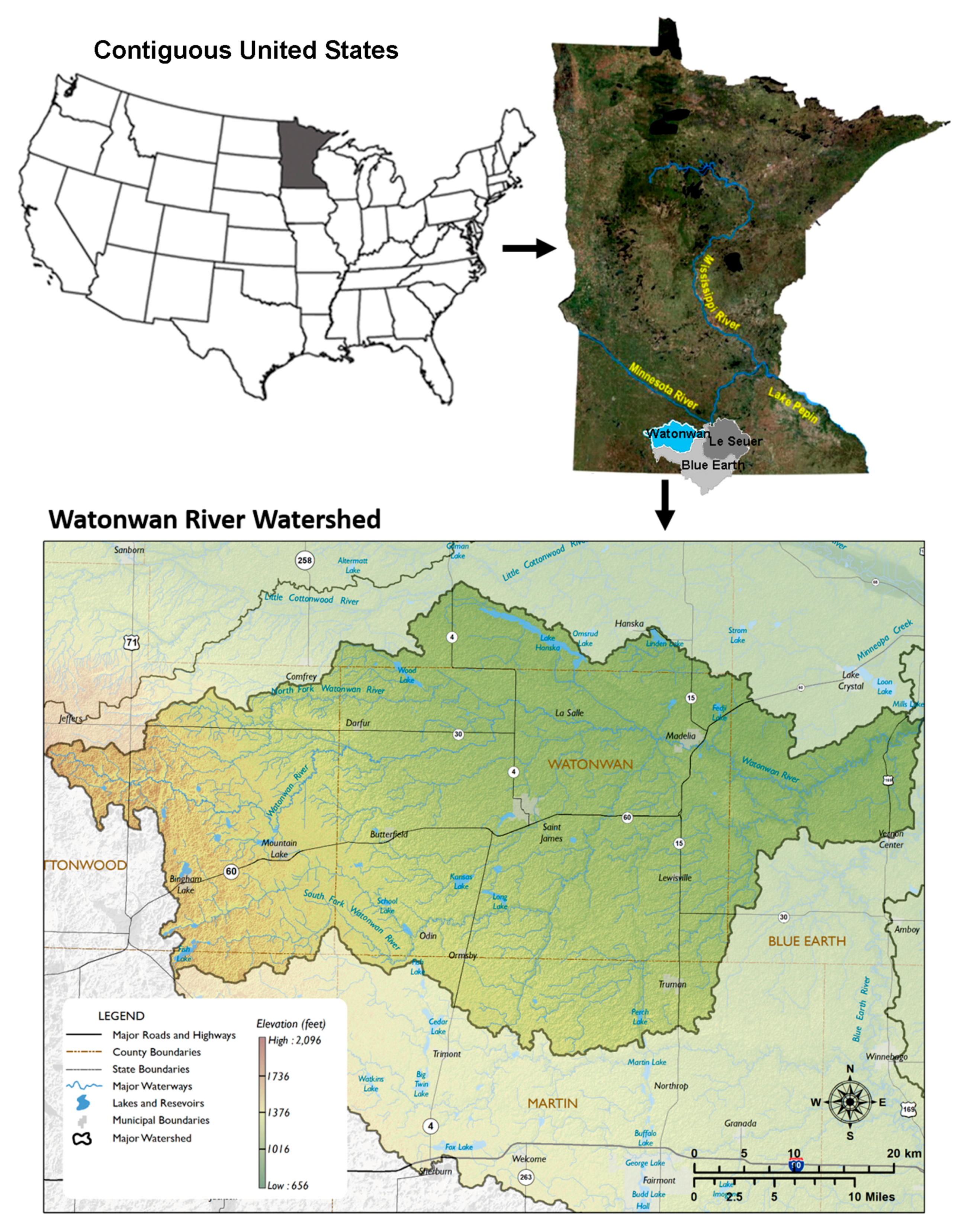
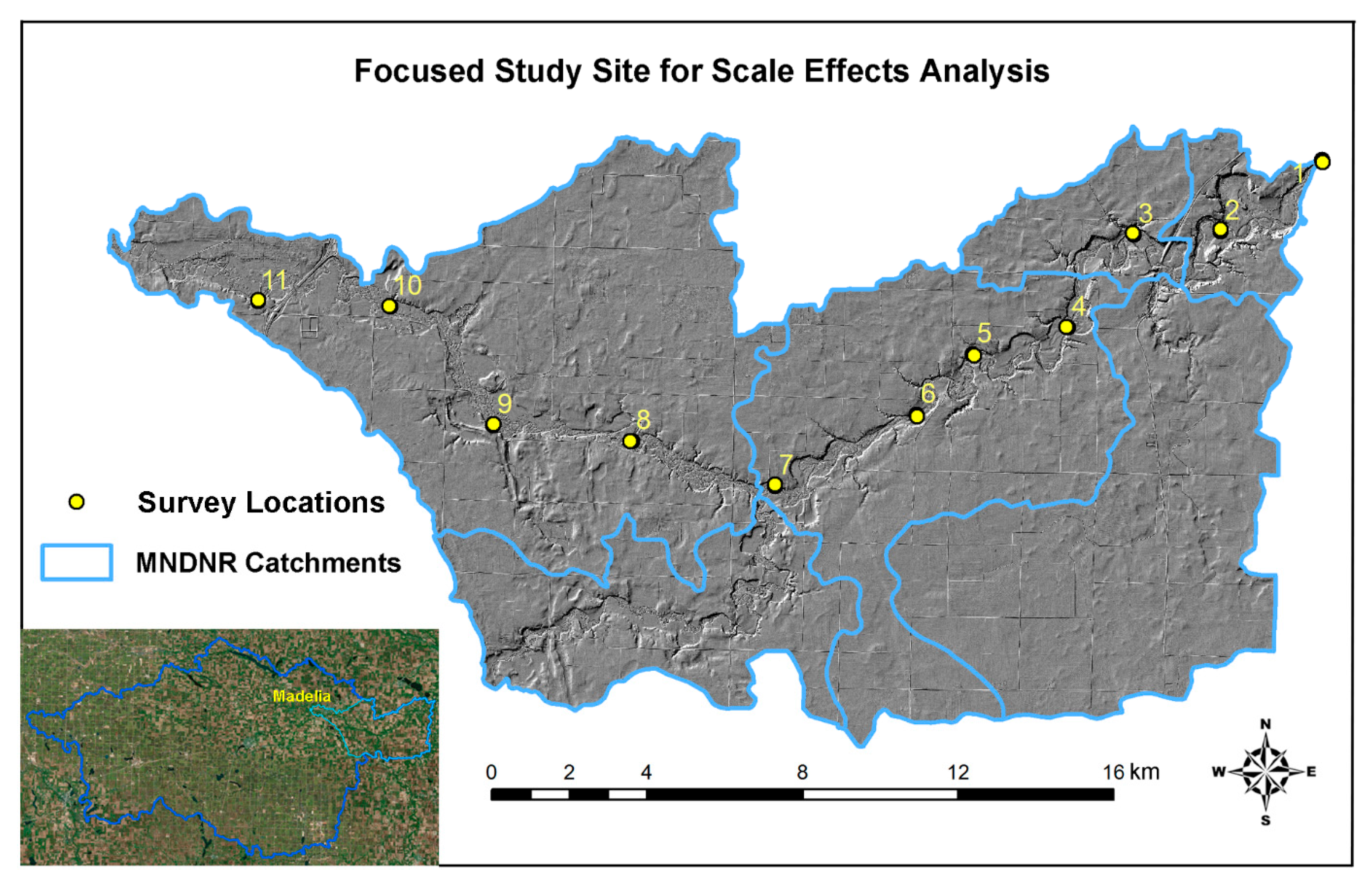
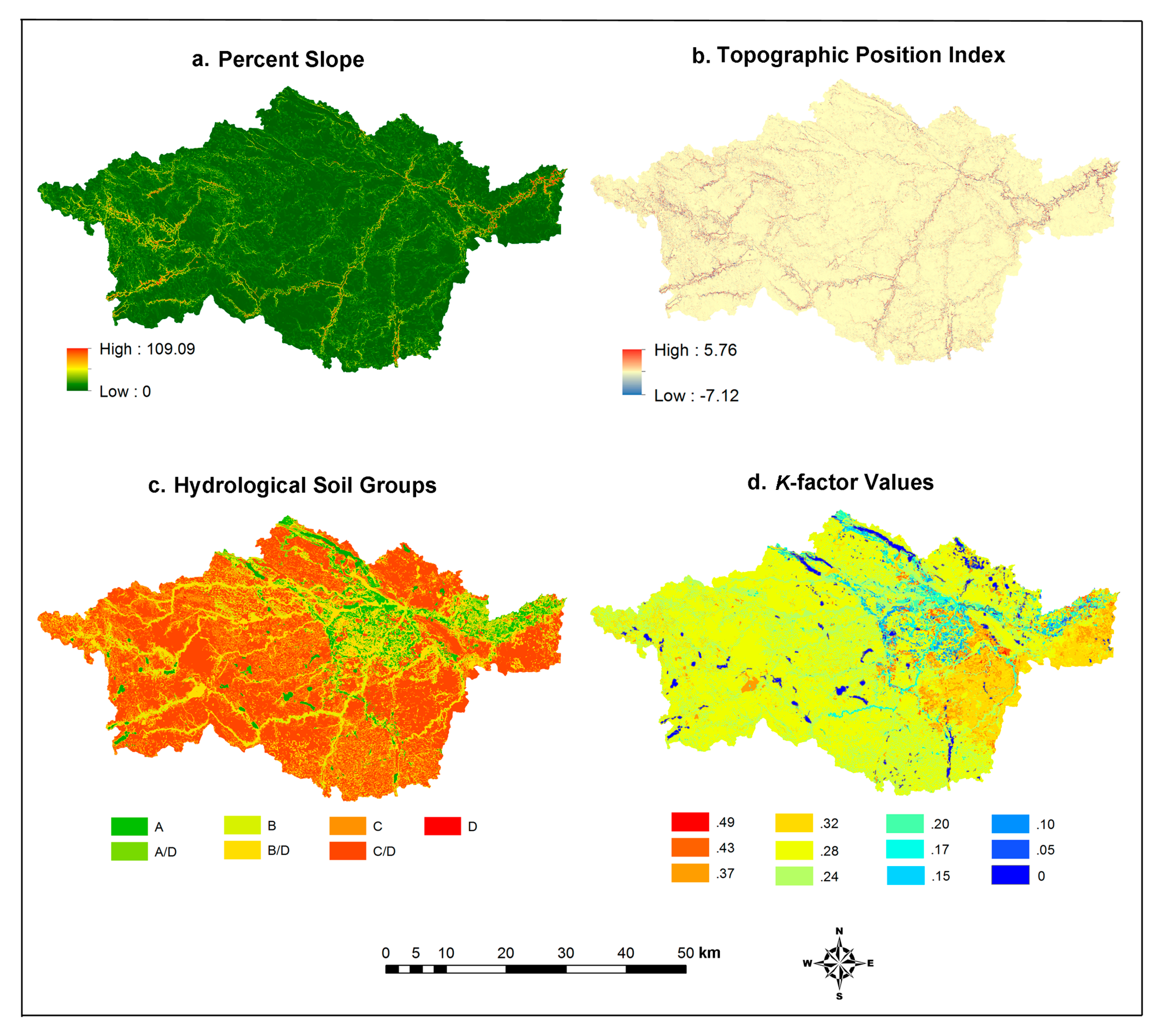
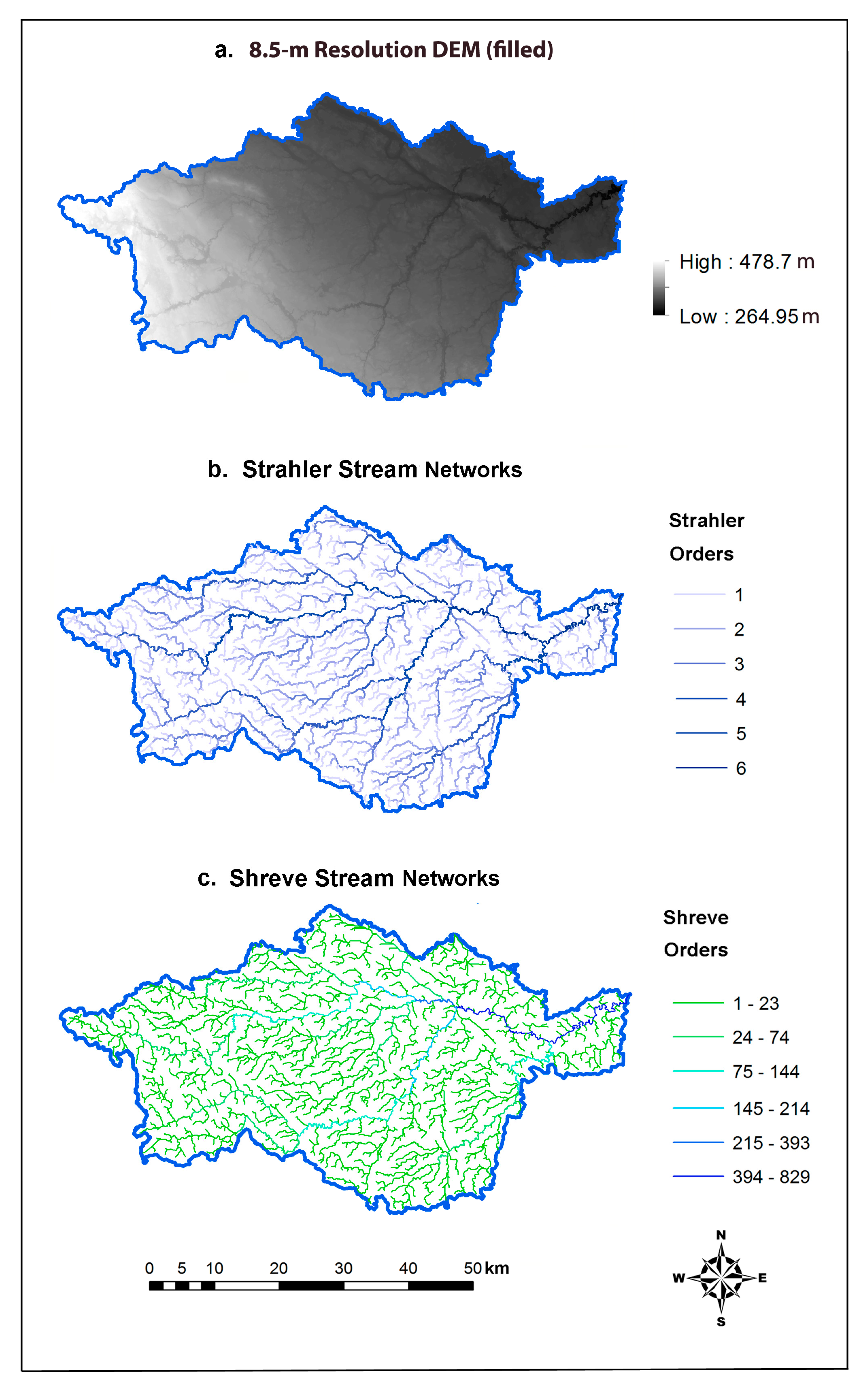

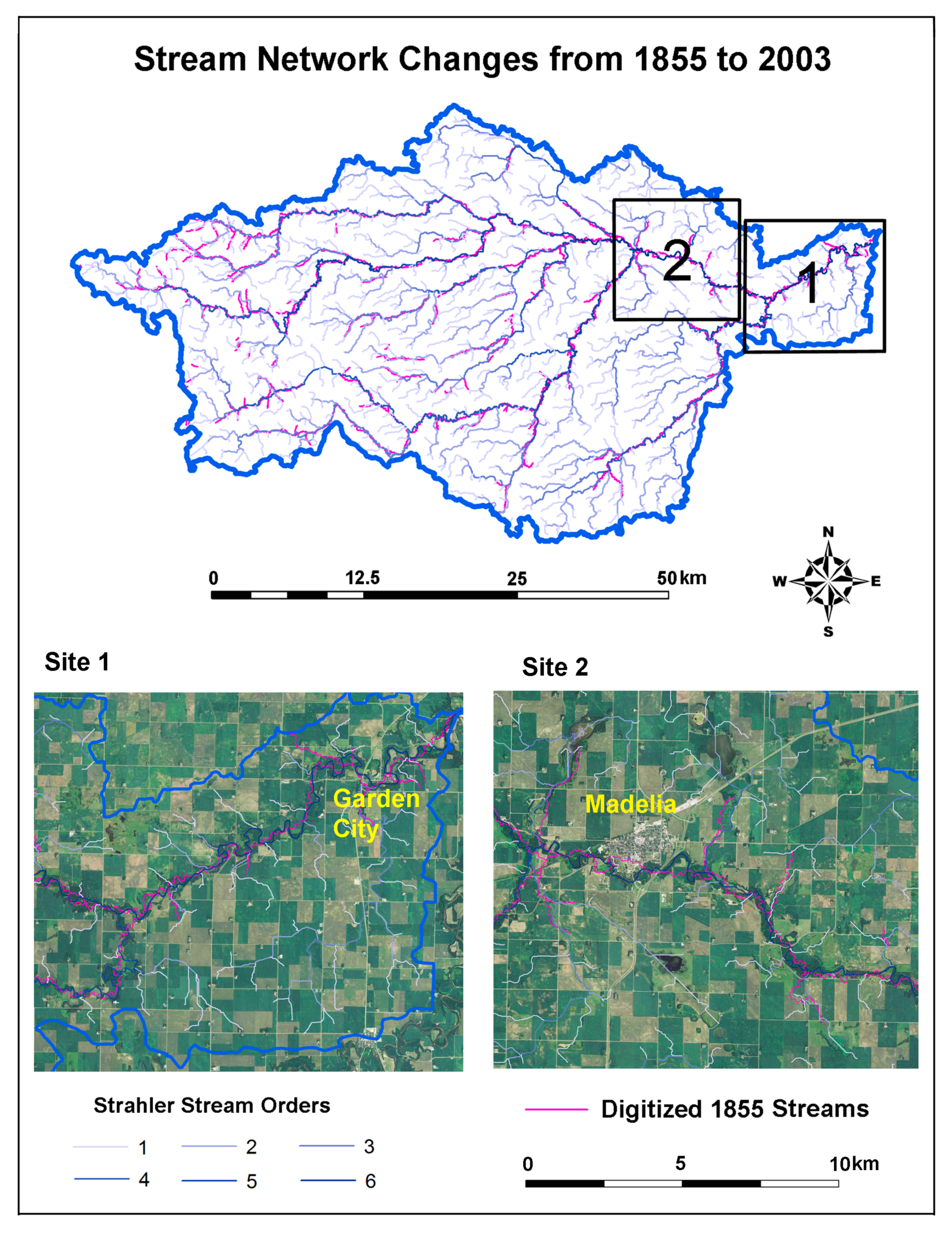

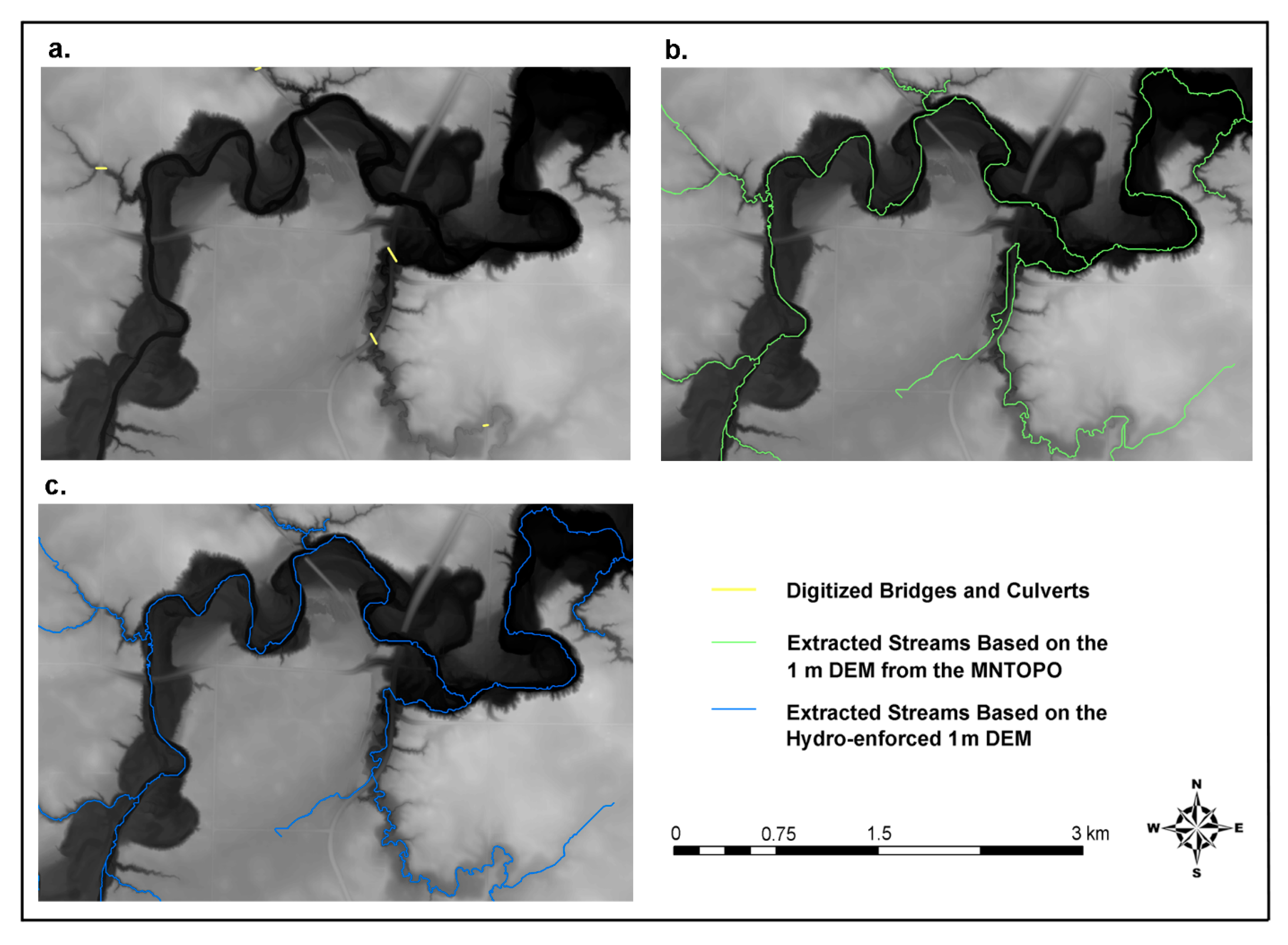
| Land Cover Class | Total Area (ha) | Percentage (%) |
|---|---|---|
| Cultivated Crops | 195,898 | 86.57 |
| Developed, Open Space | 11,835 | 5.23 |
| Emergent Herbaceous Wetlands | 5947 | 2.63 |
| Open Water | 3583 | 1.58 |
| Deciduous Forest | 2434 | 1.08 |
| Grassland/Herbaceous | 2080 | 0.92 |
| Developed, Low Intensity | 1627 | 0.72 |
| Pasture/Hay | 1185 | 0.52 |
| Other Land Covers | 1693 | 0.75 |
| Field Sample | River Width (m) | Distance Between Extracted River Center and Measured River Center (m) | |||
|---|---|---|---|---|---|
| 1-m DEM | 3-m DEM | 8.5-m DEM | 30-m DEM | ||
| 1 | 44.96 | 13.33 | 14.31 | 0.48 | 788.35 |
| 2 | 44.46 | 12.66 | 10.98 | 12.74 | 67.47 |
| 3 | 36.24 | 11.22 | 10.58 | 10.52 | 22.57 |
| 4 | 38.48 | 10.40 | 7.88 | 20.39 | 4.69 |
| 5 | 39.55 | 14.93 | 14.20 | 12.55 | 19.54 |
| 6 | 37.74 | 15.79 | 15.82 | 40.32 | 53.51 |
| 7 | 36.88 | 12.74 | 14.76 | 30.52 | 40.23 |
| 8 | 38.81 | 3.35 | 0.36 | 28.14 | 61.56 |
| 9 | 22.80 | 1.89 | 5.90 | 6.38 | 329.17 |
| 10 | 20.68 | 41.90 | 47.72 | 7.29 | 605.61 |
| 11 | 25.96 | 11.54 | 6.54 | 9.89 | 37.76 |
| Mean | 35.14 | 13.61 | 13.55 | 16.29 | 184.59 |
© 2017 by the authors. Licensee MDPI, Basel, Switzerland. This article is an open access article distributed under the terms and conditions of the Creative Commons Attribution (CC BY) license (http://creativecommons.org/licenses/by/4.0/).
Share and Cite
Yuan, F.; Larson, P.; Mulvihill, R.; Libby, D.; Nelson, J.; Grupa, T.; Moore, R. Mapping and Analyzing Stream Network Changes in Watonwan River Watershed, Minnesota, USA. ISPRS Int. J. Geo-Inf. 2017, 6, 369. https://doi.org/10.3390/ijgi6110369
Yuan F, Larson P, Mulvihill R, Libby D, Nelson J, Grupa T, Moore R. Mapping and Analyzing Stream Network Changes in Watonwan River Watershed, Minnesota, USA. ISPRS International Journal of Geo-Information. 2017; 6(11):369. https://doi.org/10.3390/ijgi6110369
Chicago/Turabian StyleYuan, Fei, Phillip Larson, Roman Mulvihill, Devon Libby, Jessica Nelson, Tyler Grupa, and Rick Moore. 2017. "Mapping and Analyzing Stream Network Changes in Watonwan River Watershed, Minnesota, USA" ISPRS International Journal of Geo-Information 6, no. 11: 369. https://doi.org/10.3390/ijgi6110369





